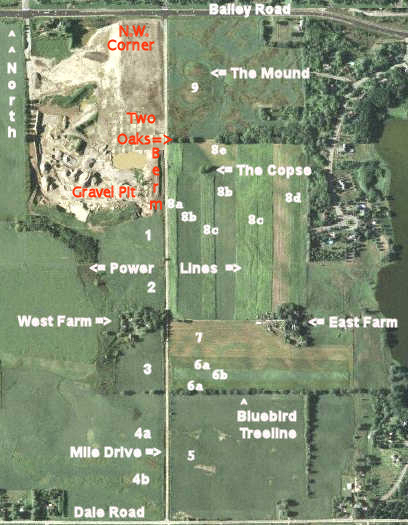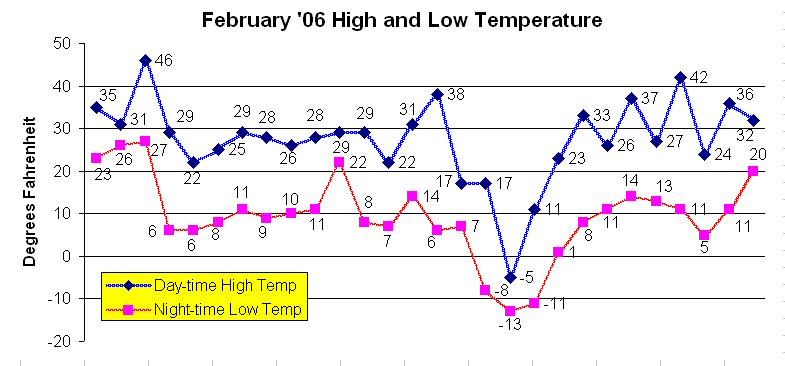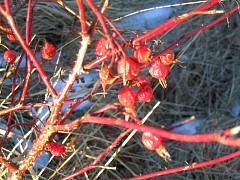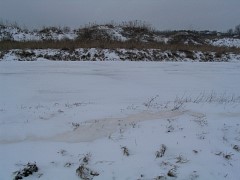

|
Here is Field #9. Note that compared to Field #5 the cornstalks in this field are all
jumbled and tumbled up. The farmer didn't plow this field after picking the corn, but
instead ran a disk over it. The disk partially turns the soil over, but doesn't completely
flip it over like a plow would. A ploughed field can lose more moisture and is more
susceptible to blowing away in the wind in the spring, or if bare (like now) in the winter.
Go to Field #5 winter
|

|
|
These are the tracks of a crow - note unsymmetrical toes.
|
|

|

We've had a bit of a cold snap, the temperature is around 15 degrees Fahrenheit. Just a few
days ago the road was muddy, and now the mud has frozen with tire tracks preserved.
|


The wild prairie rose, also known as the Arkansas wild rose (Rosa arkansana Porter). The red fruit
are known as "rose hips" and contain several hard brown seeds.
|


Cocklebur (Xanthium strumarium L.) plants near the West Farm. Cocklebur seeds and seedlings are
poisonous, and young animals can be killed by eating the succulent seedlings. The spiny bur
prevents the mature seeds from being eaten. I can't say how many of those cockleburs have
stuck on my clothes while I am out hunting. They seem to favor sticking on the inside
of shirt cuffs and pants bottoms. I wear hunting pants that have a panel made of tightly
woven fabric that won't let these pesky burs attach themselves.
|

I am walking out in Field #9 toward the mound. It's been snowing lightly and is about
20 degrees Fahrenheit. Before winter, the farmer dragged a disk over this land. Here you
see a hunk of soil around corn plant ripped roots and all from the ground by the disk.
|


I am on top of The Mound looking toward Two Oaks and the West Farm. You can see The Berm
running behind Two Oaks. The light snow isn't
showing up very well in the picture, maybe sometime I can get out during a heavy snow.
These pictures are dark because the level of light outside is low during this kind
of winter weather. Rather than doctoring the picture, what you get is what you get ...
|

Here on the mound, a quick movement at my feet revealed the blurry of a field mouse.
The hole he went into is the left-most center-bottom-most opening in the snow cover.
|

Approaching the gravel road, I noticed the difference in the color of the snow. Midwesterners
know about how dirty at times the snow cover can get. Small amounts of exposed topsoil
lend a fine amount of dirt to the snow cover. A new blanket of fresh snow is a welcome
to once again restore the whiteness of winter. The Berm is in the background.
|

Okay, okay, just a rock with new slow clinging to it's face.
|

The feet of the author on the gravel road. The new snow is not very deep.
|

Coming back, heading north and just about to the power lines. I am going to take a left
and leave the road to go view the gravel pit.
|

Giant cones of gravel, destined for cement or road construction. There are four gravel pits
that I can think of in the surrounding area. Another one near my house has ended it's
useful life and now has about 80 town homes built in it. The street running through it
is called "Quarry Ridge". Developer's are crazy people. As if "Ridge" takes away
from the fact that you are living in a hole. The rumor is that this pit will become
a holding pond as part of the county storm water drainage system.
|

I am walking along The Berm  Berm destroyed mid-2006
Berm destroyed mid-2006
 that separates the gravel pit from the gravel road. Often
when I do this I flush pheasants - but not today. I did see lots and lots of sparrows
though. In January I saw one dead on the road, probably the elder fellow of this sparrow
community. This berm will get flattened in the early summer. It wasn't a nataural formation
anyway, but wildlife made use of it. In the distance you can see a
gully that turned into a wildlife highway of sorts - pheasants used this a lot. that separates the gravel pit from the gravel road. Often
when I do this I flush pheasants - but not today. I did see lots and lots of sparrows
though. In January I saw one dead on the road, probably the elder fellow of this sparrow
community. This berm will get flattened in the early summer. It wasn't a nataural formation
anyway, but wildlife made use of it. In the distance you can see a
gully that turned into a wildlife highway of sorts - pheasants used this a lot.
|

True to form, a cocklebur has attached itself to my glove as I walked trough the cover
in the picture above.
|